“Have you heard the one about…”
“Knock, knock! Who’s there?”
Who doesn’t love a good joke or a great, loud belly laugh? In surveys of children’s reading preferences, funny books often top their lists, from classic stories of a motorcycle-riding mouse to the more recent pigeon who wants to drive a bus. Everyone loves to laugh but humor can often take several directions based on the readers themselves.
Bad Kitty author Nick Bruel told Publisher’s Weekly, that “his sense of humor developed first as a means of survival, as he believes it does for many people. Learning to adapt to challenges when he was a child, he developed an appreciation for the 'deeply important...personal joy' that comes from making people laugh.”
This week International Reading Association’s Children’s Literature and Reading SIG reviews new books that will bring about a few laughs. Older readers will appreciate some of the darker humor represented in the high school books and all ages will be reminded that having a sense of humor can help with getting through hard times.
Grades K-2
Holt, Kimberly Willis. (2014). Dinner with the Highbrows: A Story About Good (or Bad) Manners. Illus. by Kyrsten Brooker. New York: Henry Holt and Company.
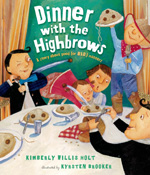 Bernard Worrywart has been invited to dinner at Gilbert Highbrow’s house. Immediately, Bernard’s mother starts his crash course in table manners and table etiquette with a long list of do’s and don’ts. When the special evening arrives and the Highbrows’ butler greets Bernard, the fun begins. The zany Highbrow family piles everyone into their limousine and heads off to an Italian restaurant. Though Bernard is still very nervous, he begins to sense the Highbrows are all about having fun. From the cowboy outfit Gilbert is wearing to his slurping and burping and throwing meatballs, all of Bernard’s mother’s lessons are coming into question. Bernard, true to his worrywart name, tries to uphold all his mother’s etiquette rules. Colorful oil-painted pictures joined by cut paper illustrations add to the zany energy of each page. A humorous way to introduce table manners, teachers will enjoy this as a read aloud.
Bernard Worrywart has been invited to dinner at Gilbert Highbrow’s house. Immediately, Bernard’s mother starts his crash course in table manners and table etiquette with a long list of do’s and don’ts. When the special evening arrives and the Highbrows’ butler greets Bernard, the fun begins. The zany Highbrow family piles everyone into their limousine and heads off to an Italian restaurant. Though Bernard is still very nervous, he begins to sense the Highbrows are all about having fun. From the cowboy outfit Gilbert is wearing to his slurping and burping and throwing meatballs, all of Bernard’s mother’s lessons are coming into question. Bernard, true to his worrywart name, tries to uphold all his mother’s etiquette rules. Colorful oil-painted pictures joined by cut paper illustrations add to the zany energy of each page. A humorous way to introduce table manners, teachers will enjoy this as a read aloud.
—Karen Hildebrand, Ohio Library and Reading Consultant
Isaacs, Ann. (2014). Meanwhile Back at the Ranch. Illus. by Kevin Hawkes. New York: Schwartz and Wade Books.
 Colorful end papers open the book with a buzzard sitting on a big sign stating; “ Under full penalty of law, exaggeration is forbidden in the state of Texas. No Texan can decorate a plain fact—except if that person is an elected official, or any one who has ever ridden a horse. In such cases, all exaggeration must be restricted to the first twenty-four hours past sunrise.” And so begins a modern folktale employing exaggeration in every illustration on every page! The year is 1870 and widow Tulip Jones of England has been notified that she has inherited $35 million dollars and a ranch in Texas. When she and her three lady servants, now ranch hands, arrive at the ranch, 1,000 bachelor Texans show up in hopes of marrying the widow and her newly inherited fortune. The hilarity begins when Tulip has to figure out a way to get rid of these crazy Texans and settle into her ranch. Kevin Hawkes’ colored pencil and acrylic illustrations add to the fun with exaggerated characters/caricatures with large Texas features. A very fun story with all the elements of a tall tale and a satisfying ending young readers will delight in hearing this ranch tale. (Originally published: Back at the Ranch. New York: Atheneum Books for Young Readers, 2009)
Colorful end papers open the book with a buzzard sitting on a big sign stating; “ Under full penalty of law, exaggeration is forbidden in the state of Texas. No Texan can decorate a plain fact—except if that person is an elected official, or any one who has ever ridden a horse. In such cases, all exaggeration must be restricted to the first twenty-four hours past sunrise.” And so begins a modern folktale employing exaggeration in every illustration on every page! The year is 1870 and widow Tulip Jones of England has been notified that she has inherited $35 million dollars and a ranch in Texas. When she and her three lady servants, now ranch hands, arrive at the ranch, 1,000 bachelor Texans show up in hopes of marrying the widow and her newly inherited fortune. The hilarity begins when Tulip has to figure out a way to get rid of these crazy Texans and settle into her ranch. Kevin Hawkes’ colored pencil and acrylic illustrations add to the fun with exaggerated characters/caricatures with large Texas features. A very fun story with all the elements of a tall tale and a satisfying ending young readers will delight in hearing this ranch tale. (Originally published: Back at the Ranch. New York: Atheneum Books for Young Readers, 2009)
—Karen Hildebrand, Ohio Library and Reading Consultant
Ketteman, Helen. (2014). There Once was a Cowpoke who Swallowed an Ant. Illus. by Will Terry.
Albert Whitman and Company.
 While we are still in Texas territory (see above) take a look at this new spinoff from the classic song, “I Know an Old Lady Who Swallowed a Fly” Texas style! Instead of the traditional creatures swallowed by the old lady, now a Texas cowpoke is gulping down critters from the Southwest. He starts with his stomach on fire by swallowing a fire ant spouting “Yippie-ti-yay! My stomach’s on fire!” as his cheeks puff out and his eyes bulge from their sockets. Next, he swallows an eight-eyed spider that wiggles and waggles inside him. A snake, a roadrunner, an armadillo, a boar and even more animals chase the ant that follows the spider. When nothing works to get rid of the fiery any, the cowboy sends in his hat, his horse, his rope, and finally himself into his own stomach after that pesky hot fire ant. Earth tone illustrations are the perfect supplement for life in the Southwest. Teachers will enjoy the Educator’s Guide to Common Core Connections provided by the publisher.
While we are still in Texas territory (see above) take a look at this new spinoff from the classic song, “I Know an Old Lady Who Swallowed a Fly” Texas style! Instead of the traditional creatures swallowed by the old lady, now a Texas cowpoke is gulping down critters from the Southwest. He starts with his stomach on fire by swallowing a fire ant spouting “Yippie-ti-yay! My stomach’s on fire!” as his cheeks puff out and his eyes bulge from their sockets. Next, he swallows an eight-eyed spider that wiggles and waggles inside him. A snake, a roadrunner, an armadillo, a boar and even more animals chase the ant that follows the spider. When nothing works to get rid of the fiery any, the cowboy sends in his hat, his horse, his rope, and finally himself into his own stomach after that pesky hot fire ant. Earth tone illustrations are the perfect supplement for life in the Southwest. Teachers will enjoy the Educator’s Guide to Common Core Connections provided by the publisher.
—Karen Hildebrand, Ohio Library and Reading Consultant
Kulling, Monica. (2014). The Tweedles Go Electric. Illus. by Marie LaFrance. Toronto: Groundwood Books/House of Anansi Press.
 This humorous tale of turn-of-the-century automobiles offers several subtle nods to the future and environmental awareness. Set in 1903, the Tweedles are the last to consider getting an automobile. They are definitely behind the times. When Mr. Tweedle finally decides to enter the 20th century and buy his automobile, he purchases a “green” electric car everyone makes fun of. Gas powered autos are the way to go, they say. Yet as the Tweedles tour around town in their green electric car they smile and insist their choice is the smart one. One day, their neighbor Mr. Hamm accidentally lops off his finger and his car is out of gas so in desperation he calls on the Tweedles to rush him to the doctor. Graphite on paper and mixed media collage illustrations represent the time period well and expressive looks on character faces add to the fun of this book. Shhhhhh, but the story also presents a bit of history as well. Introduce the book with this lively book trailer and use it as an anticipatory question set as to what is going to happen in this story.
This humorous tale of turn-of-the-century automobiles offers several subtle nods to the future and environmental awareness. Set in 1903, the Tweedles are the last to consider getting an automobile. They are definitely behind the times. When Mr. Tweedle finally decides to enter the 20th century and buy his automobile, he purchases a “green” electric car everyone makes fun of. Gas powered autos are the way to go, they say. Yet as the Tweedles tour around town in their green electric car they smile and insist their choice is the smart one. One day, their neighbor Mr. Hamm accidentally lops off his finger and his car is out of gas so in desperation he calls on the Tweedles to rush him to the doctor. Graphite on paper and mixed media collage illustrations represent the time period well and expressive looks on character faces add to the fun of this book. Shhhhhh, but the story also presents a bit of history as well. Introduce the book with this lively book trailer and use it as an anticipatory question set as to what is going to happen in this story.
—Karen Hildebrand, Ohio Library and Reading Consultant
Stein, David Ezra. (2014). I’m My Own Dog. New York: Candlewick Press.
 From Caldecott Honor winner, David Ezra Stein, young readers will enjoy seeing life through the point of view of the dog. Living life on his own, fetching his own slippers, throwing his own sticks, telling himself to roll over, he is a good dog. He can even scratch himself except for one spot right in the middle of his back. He goes to the park and finds a young man who can reach that spot and scratch it for him. The young man follows him home so dog decides to keep him. He teaches the young man how to how to walk with a leash and shows him things like squirrels and trees. The dog teaches the young man how to throw sticks. Though he often has to clean up after the young man like licking the drips from his ice cream cones, the man is learning. The pen, marker and watercolor illustrations warmly represent the relationship that is building between the two lovable characters. They end up on the couch side by side as best friends. This is a charming story that represents a point of view not often considered in the pet and owner/master relationship.
From Caldecott Honor winner, David Ezra Stein, young readers will enjoy seeing life through the point of view of the dog. Living life on his own, fetching his own slippers, throwing his own sticks, telling himself to roll over, he is a good dog. He can even scratch himself except for one spot right in the middle of his back. He goes to the park and finds a young man who can reach that spot and scratch it for him. The young man follows him home so dog decides to keep him. He teaches the young man how to how to walk with a leash and shows him things like squirrels and trees. The dog teaches the young man how to throw sticks. Though he often has to clean up after the young man like licking the drips from his ice cream cones, the man is learning. The pen, marker and watercolor illustrations warmly represent the relationship that is building between the two lovable characters. They end up on the couch side by side as best friends. This is a charming story that represents a point of view not often considered in the pet and owner/master relationship.
—Karen Hildebrand, Ohio Library and Reading Consultant
Grades 3-5
Angleberger, Tom. (2014). Emperor Pickletine Rides the Bus; An Origami Yoda Book. New York: Amulet Books/Abrams.
 Tom Angleberger brings the final volume of the Origami Yoda to middle readers with Emperor Pickletine. Tommy and his other seventh grade friends are off to Washington, D.C. for their class field trip. However, Principal Rabbski has made a pronouncement that the field trip will be an “origami-free zone.” How can that be? Even as the principal speaks, the kids are folding any paper they can get their hands on. Fortunately, Dwight brought hundreds of lime fruit roll-ups for the trip so Fruitigami Yoda is the new creation. Making Tommy miserable, Harvey is not only his bus buddy but he also brought evil Emperor Pickletine with him. The field trip takes the gang to the nation’s capital and so a new file has opened for the group to pursue. Visit the author’s website, Origami Yoda, for extensive resources and folding exercises to accompany this popular series for middle grade readers.
Tom Angleberger brings the final volume of the Origami Yoda to middle readers with Emperor Pickletine. Tommy and his other seventh grade friends are off to Washington, D.C. for their class field trip. However, Principal Rabbski has made a pronouncement that the field trip will be an “origami-free zone.” How can that be? Even as the principal speaks, the kids are folding any paper they can get their hands on. Fortunately, Dwight brought hundreds of lime fruit roll-ups for the trip so Fruitigami Yoda is the new creation. Making Tommy miserable, Harvey is not only his bus buddy but he also brought evil Emperor Pickletine with him. The field trip takes the gang to the nation’s capital and so a new file has opened for the group to pursue. Visit the author’s website, Origami Yoda, for extensive resources and folding exercises to accompany this popular series for middle grade readers.
—Karen Hildebrand, Ohio Library and Reading Consultant
Comics Squad: Recess. (2014). Comics by Jennifer L. Holm & Matthew Holm, Jarrett J. Krosoczka, Dav Pilkey, Dan Santat, Gene Luen Yang, Raina Telgemeier, Dave Roman, Ursula Vernon, Eric Wight; Edited by Jennifer L. Holm, Matthew Holm, & Jarrett J. Krosoczka. New York: Random House.
 What happens when you bring 10 popular and funny children’s book author/illustrators together and ask them to write about school recess? Readers get a most hilarious group of stories to enjoy over and over. Babymouse and Lunch Lady are joined by other characters from people to vegetables in this anthology sharing the theme of recess-time antics. The artwork is true to each contributor’s recognizable comic style. Cartoons, invented spelling, caricatures, comic-strips, romance, sports, kickball, homework, pizza, dinosaurs, ninjas, and more are found within the pages of these hilarious stories. Teachers might enjoy using the book trailer to introduce the stories.
What happens when you bring 10 popular and funny children’s book author/illustrators together and ask them to write about school recess? Readers get a most hilarious group of stories to enjoy over and over. Babymouse and Lunch Lady are joined by other characters from people to vegetables in this anthology sharing the theme of recess-time antics. The artwork is true to each contributor’s recognizable comic style. Cartoons, invented spelling, caricatures, comic-strips, romance, sports, kickball, homework, pizza, dinosaurs, ninjas, and more are found within the pages of these hilarious stories. Teachers might enjoy using the book trailer to introduce the stories.
—Karen Hildebrand, Ohio Library and Reading Consultant
Einhorn, Edward. (2014). Fractions in Disguise: A Math Adventure. Illus. by David Clark. New York: Charlesbridge.
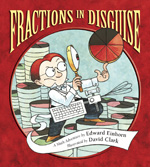 George Cornelius Factor (G.C.F. = Greatest Common Factor) collects fractions. When George learns the coveted 5/8 is up for auction, he is ready to start the bidding. Unfortunately, there are others interested in this rare numeral as well. Baron von Mathematik and Madame de Gomtrique will be bidding against George. However, evil Dr. Brok steals the famous fraction before the others get a chance to buy. Now the adventure really begins as George invents the Reducer, his half ray gun/half calculator that penetrates the disguise of Dr. Brok and the purloined fraction. Ink and watercolor cartoon illustrations add to the fun and mystery of the chase as George heads to Dr. Brok’s mansion. Combining math, mystery and comedy provide a very entertaining read (and read-aloud!) for middle readers and math nerds everywhere!
George Cornelius Factor (G.C.F. = Greatest Common Factor) collects fractions. When George learns the coveted 5/8 is up for auction, he is ready to start the bidding. Unfortunately, there are others interested in this rare numeral as well. Baron von Mathematik and Madame de Gomtrique will be bidding against George. However, evil Dr. Brok steals the famous fraction before the others get a chance to buy. Now the adventure really begins as George invents the Reducer, his half ray gun/half calculator that penetrates the disguise of Dr. Brok and the purloined fraction. Ink and watercolor cartoon illustrations add to the fun and mystery of the chase as George heads to Dr. Brok’s mansion. Combining math, mystery and comedy provide a very entertaining read (and read-aloud!) for middle readers and math nerds everywhere!
—Karen Hildebrand, Ohio Library and Reading Consultant
Jocelyn, Marthe, and Richard Scrimger. (2014). Viminy Crowe’s Comic Book. Comics by Claudia Dávila. Toronto, Ontario, CA: Tundra Books.
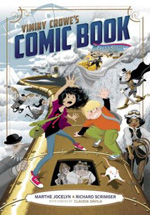 Fast-moving thrills with comedic humor mark this adventure with a ComicCon twist. Blending narrative with comics this tale offers a humorous story for readers who like adventure with a laugh. Addy Crowe along with her pal Catnip the rat are helping her Uncle Viminy Crowe with his booth at the International Comic Book Festival. Uncle Viminy is the creator of the popular comic starring Flynn Goster. In a rather catastrophic lunch disaster ending with a spilled lunch, young Wylder Wallace is embarrassed at his clumsiness, but discovers Addy’s copy of her uncle’s latest book Flynn Goster in Gold Rush Train while she is in the restroom cleaning up. Flynn Goster is Wylder’s favorite!! As luck would have it when Wylder follows Addy to the washroom, they discover a portal to into the Flynn Goster comic. They are now on the Gold Rush Train and tumble into the adventure along with Goster himself. Include all the possibilities that steampunk offers, like robots and a villain named Aldous Lickpenny, and the fantasy adventures takes flight.
Fast-moving thrills with comedic humor mark this adventure with a ComicCon twist. Blending narrative with comics this tale offers a humorous story for readers who like adventure with a laugh. Addy Crowe along with her pal Catnip the rat are helping her Uncle Viminy Crowe with his booth at the International Comic Book Festival. Uncle Viminy is the creator of the popular comic starring Flynn Goster. In a rather catastrophic lunch disaster ending with a spilled lunch, young Wylder Wallace is embarrassed at his clumsiness, but discovers Addy’s copy of her uncle’s latest book Flynn Goster in Gold Rush Train while she is in the restroom cleaning up. Flynn Goster is Wylder’s favorite!! As luck would have it when Wylder follows Addy to the washroom, they discover a portal to into the Flynn Goster comic. They are now on the Gold Rush Train and tumble into the adventure along with Goster himself. Include all the possibilities that steampunk offers, like robots and a villain named Aldous Lickpenny, and the fantasy adventures takes flight.
—Karen Hildebrand, Ohio Library and Reading Consultant
Snicket, Lemony. (2014). File Under: 13 Suspicious Incidents. Art by Seth. Little, Brown and Company.
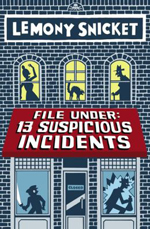 Fans of short stories will enjoy this new addition to the works of Lemony Snicket (Daniel Handler) and his tongue-in-cheek humor. Framed by 13 short mysteries the book will remind some folks of the Encyclopedia Brown mysteries published first in 1963 and continuing through 2012. The author even includes the name of Dr. Sobol for the local veterinarians as a nod toward the EB author, Donald Sobol. The setting is still Stain’d-by-the-Sea and Young Lemony Snicket continues trying to figure out the strange happenings around him. However, this new volume contains 13 short mysteries with answers in the back of the book. He leaves plenty of clues along the way for readers to attempt to solve the mystery themselves. The illustrations are an integral part of the mysteries as clues are embedded into the pictures. Snicket’s signature wordplay for children (and adults) is sprinkled throughout and offers a fun as well as intriguing story for a wide range of readers.
Fans of short stories will enjoy this new addition to the works of Lemony Snicket (Daniel Handler) and his tongue-in-cheek humor. Framed by 13 short mysteries the book will remind some folks of the Encyclopedia Brown mysteries published first in 1963 and continuing through 2012. The author even includes the name of Dr. Sobol for the local veterinarians as a nod toward the EB author, Donald Sobol. The setting is still Stain’d-by-the-Sea and Young Lemony Snicket continues trying to figure out the strange happenings around him. However, this new volume contains 13 short mysteries with answers in the back of the book. He leaves plenty of clues along the way for readers to attempt to solve the mystery themselves. The illustrations are an integral part of the mysteries as clues are embedded into the pictures. Snicket’s signature wordplay for children (and adults) is sprinkled throughout and offers a fun as well as intriguing story for a wide range of readers.
—Karen Hildebrand, Ohio Library and Reading Consultant
Grades 6-8
Kinard, Kami. (2014). The Boy Problem (Notes and Predictions of Tabitha Reddy.) New York: Scholastic Press.
 For girl readers who enjoyed Kara in The Boy Project (2012),this new installment about Kara’s BFF Tabitha, though she prefers to be called Tabbi, is sure to please. Tabbi enters seventh grade and is looking for a sign that will lead her to a boyfriend. Not just any boy will do. She wants a boy who will elevate her social status and make it possible for her to hang out as couples with Kara and her boyfriend Chip. As Tabbi looks for the signs to her love interest she finds signs in a Magic 8 Ball and a blob of cheese pizza. She finally decides upon a more mathematical approach. Her math teacher assigns a project in probability and Tabbi sees this as a chance to create the signs she needs through surveys, charts, and other data collecting techniques. Written in the form of a diary and illustrated in cartoon-like characters this lighthearted romp with tween romance and math will produce a lot of laughs.
For girl readers who enjoyed Kara in The Boy Project (2012),this new installment about Kara’s BFF Tabitha, though she prefers to be called Tabbi, is sure to please. Tabbi enters seventh grade and is looking for a sign that will lead her to a boyfriend. Not just any boy will do. She wants a boy who will elevate her social status and make it possible for her to hang out as couples with Kara and her boyfriend Chip. As Tabbi looks for the signs to her love interest she finds signs in a Magic 8 Ball and a blob of cheese pizza. She finally decides upon a more mathematical approach. Her math teacher assigns a project in probability and Tabbi sees this as a chance to create the signs she needs through surveys, charts, and other data collecting techniques. Written in the form of a diary and illustrated in cartoon-like characters this lighthearted romp with tween romance and math will produce a lot of laughs.
—Karen Hildebrand, Ohio Library and Reading Consultant
Paulsen, Gary. (2014). Family Ties. New York: Wendy Lamb Books.
 Popular author Gary Paulsen has added another companion volume to the books, Liar Liar, Flat Broke, Crush, and Vote. Kevin Spencer is back as the main character in another humorous story for middle grade boys. Kevin decides to take on the role of backyard wedding planner when his Uncle Will arrives with his new bride-to-be, her arson-leaning son and their incontinent dog. As the guests arrive, readers will get a real feel for the bizarre family surrounding Kevin. His grandmother Lucille is the first guest followed by Kevin’s grandfather who is now Lucille’s ex-husband. He arrives with his showgirl female companion. More crazy relatives and friends present themselves and Kevin’s plan for a simple backyard wedding starts to get complicated. He is also really trying to impress his own girlfriend, Tina. Adding to Kevin’s chaos he is carrying around a fake baby, actually made of popcorn, as part of a school assignment. Bringing family together, including his father and estranged brother, proves quite a feat, but this dysfunctional family eventually figures out a happy ending.
Popular author Gary Paulsen has added another companion volume to the books, Liar Liar, Flat Broke, Crush, and Vote. Kevin Spencer is back as the main character in another humorous story for middle grade boys. Kevin decides to take on the role of backyard wedding planner when his Uncle Will arrives with his new bride-to-be, her arson-leaning son and their incontinent dog. As the guests arrive, readers will get a real feel for the bizarre family surrounding Kevin. His grandmother Lucille is the first guest followed by Kevin’s grandfather who is now Lucille’s ex-husband. He arrives with his showgirl female companion. More crazy relatives and friends present themselves and Kevin’s plan for a simple backyard wedding starts to get complicated. He is also really trying to impress his own girlfriend, Tina. Adding to Kevin’s chaos he is carrying around a fake baby, actually made of popcorn, as part of a school assignment. Bringing family together, including his father and estranged brother, proves quite a feat, but this dysfunctional family eventually figures out a happy ending.
—Karen Hildebrand, Ohio Library and Reading Consultant
Williams, Maiya. (2014). Middle School Cool. Illus. by Karl Edwards. New York: Delacorte Press.
 A new alternative school is opening in Horsemouth, NH. The new school is called Kaboom Academy, founded by Dr. Kaboom and housed in a former mental institution. Interestingly, some of the staff are former patients. Determined to create an atmosphere where troubled students who have previously not been successful at public school education, Dr. Kaboom implements techniques such as pills for learning the classics rather than traditional reading assignments. Dodgeballs can rigorously throw themselves and instead of bells to end classes, gongs and cannons go off to let everyone know class is over. The story features the Journalism 1A class and the Daily Dynamite student newspaper. When nine young investigative reporters discover a secret about Dr. Kaboom that could threaten the existence of the school, they are faced with a publishing dilemma. Though the storyline sometimes gets a little anti-public school, the zany antics of staff and students will make this a very fun read. For kids who enjoyed Louis Sachar’s Wayside School stories, this will be a welcome addition to non-traditional schools.
A new alternative school is opening in Horsemouth, NH. The new school is called Kaboom Academy, founded by Dr. Kaboom and housed in a former mental institution. Interestingly, some of the staff are former patients. Determined to create an atmosphere where troubled students who have previously not been successful at public school education, Dr. Kaboom implements techniques such as pills for learning the classics rather than traditional reading assignments. Dodgeballs can rigorously throw themselves and instead of bells to end classes, gongs and cannons go off to let everyone know class is over. The story features the Journalism 1A class and the Daily Dynamite student newspaper. When nine young investigative reporters discover a secret about Dr. Kaboom that could threaten the existence of the school, they are faced with a publishing dilemma. Though the storyline sometimes gets a little anti-public school, the zany antics of staff and students will make this a very fun read. For kids who enjoyed Louis Sachar’s Wayside School stories, this will be a welcome addition to non-traditional schools.
—Karen Hildebrand, Ohio Library and Reading Consultant
Grades 9-12
Hale, Kathleen. (2014). No One Else Can Have You. New York: Harper Teen/HarperCollins.
 Author Kathleen Hale brings murder and dark humor together in this story set in Friendship, WI, don’tcha know. Using the regional expressions like those heard in the movie Fargo, Kippy Bushman has taken it upon herself to find the killer who murdered her best friend and homecoming queen, Ruth Fried. Feeling that Sheriff Staake isn’t on the right track to solve the murder, Kippy is trying to prove Ruth’s boyfriend is not the killer. Kippy begins her sleuthing with Ruth’s diary which proves to reveal many things about Ruth that Kippy was previously unaware. Kippy enlists the help of Ruth’s older brother, Davey, who has recently returned from his tour in Afghanistan. In addition, Kippy is still working through the death of her own mother years earlier. Her relationship with Davey evolves into an awkward romance of sorts as they plod through people and clues in trying to find the real killer. With the charm of small town life and the closeness of family and community readers will find an interesting tale to keep them wondering.
Author Kathleen Hale brings murder and dark humor together in this story set in Friendship, WI, don’tcha know. Using the regional expressions like those heard in the movie Fargo, Kippy Bushman has taken it upon herself to find the killer who murdered her best friend and homecoming queen, Ruth Fried. Feeling that Sheriff Staake isn’t on the right track to solve the murder, Kippy is trying to prove Ruth’s boyfriend is not the killer. Kippy begins her sleuthing with Ruth’s diary which proves to reveal many things about Ruth that Kippy was previously unaware. Kippy enlists the help of Ruth’s older brother, Davey, who has recently returned from his tour in Afghanistan. In addition, Kippy is still working through the death of her own mother years earlier. Her relationship with Davey evolves into an awkward romance of sorts as they plod through people and clues in trying to find the real killer. With the charm of small town life and the closeness of family and community readers will find an interesting tale to keep them wondering.
—Karen Hildebrand, Ohio Library and Reading Consultant
Longo, Jennier. (2014). Six Feet Over It. New York: Random House.
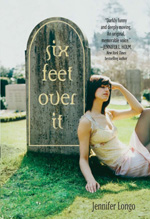 Fourteen-year-old Leigh feels like she is experiencing the perfect storm. Just after the death of her friend Emily and watching as her sister Kai recovers from cancer, her father decides to buy a cemetery/memorial park and move the whole family from beautiful coastal Mendocino, California, inland to the small town of Hangland. If this isn’t too much, now her father expects her to help sell gravesites. As Leigh quickly learns, there are two types of buyers. The Pre-Needs are the people who are planning ahead and buy their lots now. The others she calls At Need and they have recently lost a loved one and need a plot immediately. Leigh is struggling to allow herself to make new friendships. When nineteen-year-old Dario shows up to work as a gravedigger, the hint of romance begins. It is Dario who helps Leigh emerge from her shell and begin to form new relationships. The humor comes in the form of Leigh’s wit and dark humor in addition to the bursts of joy from her father. Like the book in the previous review, dark humor is often best appreciated by older readers.
Fourteen-year-old Leigh feels like she is experiencing the perfect storm. Just after the death of her friend Emily and watching as her sister Kai recovers from cancer, her father decides to buy a cemetery/memorial park and move the whole family from beautiful coastal Mendocino, California, inland to the small town of Hangland. If this isn’t too much, now her father expects her to help sell gravesites. As Leigh quickly learns, there are two types of buyers. The Pre-Needs are the people who are planning ahead and buy their lots now. The others she calls At Need and they have recently lost a loved one and need a plot immediately. Leigh is struggling to allow herself to make new friendships. When nineteen-year-old Dario shows up to work as a gravedigger, the hint of romance begins. It is Dario who helps Leigh emerge from her shell and begin to form new relationships. The humor comes in the form of Leigh’s wit and dark humor in addition to the bursts of joy from her father. Like the book in the previous review, dark humor is often best appreciated by older readers.
—Karen Hildebrand, Ohio Library and Reading Consultant
These reviews are submitted by members of the International Reading Association's Children's Literature and Reading Special Interest Group (CL/R SIG) and are published weekly on Reading Today Online.